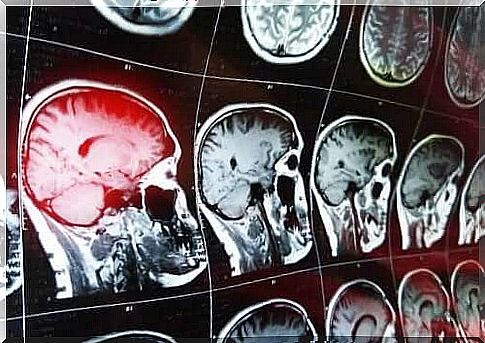What Are Confabulations And Why Do They Occur?

To understand a confabulation, it is important to know that it comes from a distortion of memories. Memory is one of the most studied human cognitive processes, but it is nevertheless a complex subject. In this article, we’ll take a closer look at what confabulations are and why they occur.
The events in memory are not built into the mind exactly as the event actually went. Each person can remember an event in a slightly different way and assure them that is exactly how things went. This is a distortion of reality due to the loss of knowledge.
One clear example is obtained from elderly people with significant neurocognitive impairment (senile dementia). They are convinced that they have experienced something completely differently than how it actually went.
Confabulations: different types and classification
Confabulations are a cognitive phenomenon that is difficult to classify because they can manifest in a number of different ways. However, these cognitive abnormalities can be divided into groups based on five criteria.
Let’s look at them next.
1. Spontaneous confabulations
This type of confabulation is short. It is an imaginary idea that a person asserts is true in a clear way. This usually happens in patients with Korsakoff syndrome.
2. Created confabulations
In this case, a person’s memory deceives so that something doesn’t come to mind accurately. This is common in patients with amnesia. The same thing happens when a healthy person tries to bring information back to their mind for a long time.
For example, reading an experiment from external memory can lead to memory failure during recall. Some concepts may be confused with each other and may be considered true during the experiment, even if they do not correspond to reality.

3. Simple thoughts that penetrate the mind
These distortions occur when a person tries to remember information in detail. For example, suppose you forget your Shopping List and try to remember what it read. You may unknowingly buy something that wasn’t on the list and still be convinced it was.
4. Momentary confabulations
This kind of memory betrayal is the most common type of confabulation, and stories can be contrived but completely believable.
These are also easier to identify; for example, when a patient communicates their plans in great detail but it is clear to the listener that they are not feasible. This is common in nursing homes where the elderly claim to go to visit their childhood friends soon, even though these may already be dead.
5. Forged confabulations
Such confabulations are the most volatile due to the fact that the people in question are very detached from reality. As the name suggests, these are purely imaginary stories that are only credible to the patient himself. Such a distortion of reality is common in psychotic patients and those with paralytic dementia.
Another method of classification
The above classification into five categories is derived from Kopelman and most accurately defines the intensity and frequency of confabulations. Another method that has been used for years is the classification proposed by Schnider, which consists of four criteria:
- Contents. Determining the credibility of a story can be done using boundaries that range from truth to falsehood.
- The way they manifest. Are they spontaneous or created?
- The subject area in which they occur. Are they episodic, autobiographical, generally semantic, or personally semantic?
- Clinical syndrome in which they occur.
What are the symptoms associated with confabulations?
Symptoms of confabulation vary depending on what is causing the underlying disorder. For example, the most characteristic symptoms of Alzheimer’s disease are cognitive deficits, decline in mental abilities, and memory problems.
The following are the other symptoms that may occur depending on the neurological disorder in question:
- Dementia: memory impairment and nervousness.
- Schizophrenia: thought disorder, auditory hallucinations and paranoia.
- Korsakoff syndrome: local memory loss, mania, and repetitive behavior.
- Asomatognosia: the inability to become aware of or recognize your own body parts; false feelings related to the loss of a limb.
Possible causes of confabulations
The causes of conflational memory failure in patients are the result of damage to the front of the brain. More specifically, damage to the area in which the orbitofrontal and ventromedial areas are located.
There are three theories that seek to explain the causes of confabulations. We will look at them next. It is important to know that these hypotheses come from a neuropsychological perspective.
1. Memory malfunction
This theory states that confabulations are a form of amnesia. The most important assumption is that errors in recollection are a means of making sense of imperfect memories that man cannot recall. This hypothesis is generally accepted.
2. Execute disorder
This theory states that conflation-causing memory errors occur when there are severe mental limitations in planning and setting concrete goals.
3. The dual hypothesis
In this hypothesis, the approach does not rule out any previous assumptions but further states that the confabulations are due to a disturbance in the executive processes (higher functions of consciousness), in addition to memory errors.
Care

Confabulations are considered an untreated consequence, but one approach can improve the quality of life of patients with a history of brain injury. It is a neuropsychological method based on intervention through cognitive stimulation.
The treatment was designed by researchers at the University of Granada. It displays a series of images to patients in order, the content of which may vary. Patients are then asked to recall what they saw. When patients try to remember, confabulations arise, and at this point, experts are missing the game.
Patients need to be stressed that the memory images they claim to be true are not correct, after which they are shown the images again while explaining that their memory is doing tricks. In neuropsychology, this process is referred to as feedback. Improvement can be expected after about nine sessions.
What can you do if someone you know happens to be?
If you know a person who you think is hurting, it’s best not to suddenly tell him or her that he or she is wrong. Remember that these “facts” are real to the person themselves, so be compassionate and avoid causing the person more stress.
Next, you should consult an expert who can make an assessment of the person and determine the severity of the lesion in order to draw up a treatment plan. Some patients stop telling after a while and do not need to be taken to the hospital.









